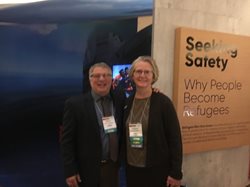
The camera zooms in on small boats taking on water and bobbing in the sea, filled with so many people that they are perilously close to capsizing. It's difficult to watch. Thankfully, a rescue boat arrives and begins pulling people to safety. The scene then shifts to a man standing amidst a giant menagerie of life vests piled in massive mounds, grimly sorting them by size: one for a small child, one for an adolescent, another for adults.
“Every one of these life jackets has a history and a life,” he says.
So begins “The Refugee Journey to Wellbeing,” an interactive exhibit on display at the 2016 ASTMH Annual Meeting organized by ASTMH in partnership with the US Centers for Disease Control and Prevention (CDC), along with colleagues at the International Organization on Migration, Médecins Sans Frontières (MSF), and the UN High Commissioner on Refugees.
The film captures poingant scenes from the wrenching journey undertaken by just a sample of the 65.3 million people ensnared in today’s global refugee crisis. It then continues with mock-ups of refugee camp reception and screening centers to demonstrate how refugees are registered and then carefully and thoroughly assessed and treated for health problems before being resettled.
Martin Cetron, MD, (left, in photo) director of the CDC’s Division of Global Migration and Quarantine, said the goal of the exhibit is to “reach the head and the heart,” to depict both the intense emotions of the refugee experience and to educate people about the extensive health screening and treatment that occurs before refugees resettle in the United States or other host countries.
“Poor health is often the most significant reason why some people fail to integrate into a new community,” he said. “For example, for a child, doing well in school often depends on getting rid of their intestinal parasites.”
Cetron said the ASTMH Annual Meeting is the perfect place to stage such an exhibition. He noted that many of the 4300 attendees at the conference are likely to encounter a refugee in their clinical work, but typically toward the end of the refugee’s journey. The exhibit, he said, is designed to depict the full chronology of the refugee experience: what drives people to flee, what happens when camps are set-up, and what sort of health interventions occur before resettlement.
Incoming ASTMH President Patricia F. Walker, MD, DTM&H, (right, in photo) Medical Director at the HealthPartners Travel and Tropical Medicine Center at the University of Minnesota, said the exhibit offers an accurate assessment of the incredible progress that has occurred in the field of refugee health.
“I’ve been working in refugee health since 1979, so I have watched the field evolve,” she said. “When I look today at the kinds of things that are happening for refugees internationally and when they come to the U.S., it’s a different and much improved world.”
In particular, Walker noted that the health screening and treatments now available are bringing a much more “scientific, compassionate and cost-effective” approach to refugee health concerns. She noted that, today, refugees seeking to resettle in the United States undergo a far more intensive health screening than almost any other person coming into the country.
Walker said there’s only one downside of the improved approach to refugee health.
“My job is not as exciting as it used to be,” she said, “because by the time they arrive here, most refugees already have been treated for their health concerns.”
Walker said the exhibit was an appropriate follow-up to the mock-up of the Ebola treatment unit that was featured at the 2015 ASTMH Annual Meeting, as both took on a “hot topic in global health” and offered a compelling and educational approach to an issue that can generate fear and mistrust.